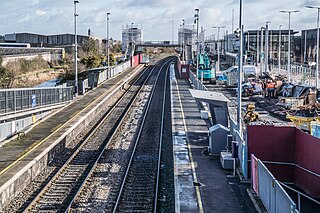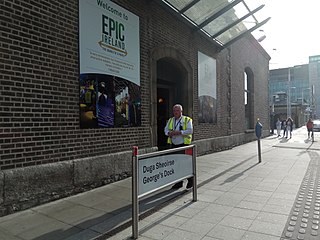
The Dublin Area Rapid Transit system is an electrified commuter rail railway network serving the coastline and city of Dublin, Ireland. The service makes up the core of Dublin's suburban railway network, stretching from Greystones, County Wicklow, in the south to Howth and Malahide in north County Dublin. The DART serves 31 stations and consists of 53 route kilometres of electrified railway, and carries in the region of 20 million passengers per year. In a similar manner to the Berlin S-Bahn, the DART blends elements of a commuter rail service and a rapid transit system.

The Royal Canal is a canal originally built for freight and passenger transportation from Dublin to Longford in Ireland. It is one of two canals from Dublin to the River Shannon and was built in direct competition to the Grand Canal. The canal fell into disrepair in the late 20th century, but much of it has since been restored for navigation. The length of the canal to the River Shannon was reopened on 1 October 2010, but a final spur branch, to Longford Town, remains closed.

Connolly station or Dublin Connolly is one of the busiest railway stations in Dublin and Ireland, and is a focal point in the Irish route network. On the North side of the River Liffey, it provides InterCity, Enterprise and commuter services to the north, north-west, south-east and south-west. The north–south Dublin Area Rapid Transit (DART) and Luas red line light rail services also pass through the station. The station offices are the headquarters of Irish Rail, Iarnród Éireann. Opened in 1844 as Dublin Station, the ornate facade has a distinctive Italianate tower at its centre.

Broadstone is one of the three neighbourhoods that make up present-day Phibsboro in Dublin, Ireland. The most southerly of these, it begins just two kilometres north of Father Mathew Bridge at Ormond Quay. The area is triangular, bounded by Phibsborough Road and Constitution Hill to the West, North Circular Road to the north, and Dorset Street and Bolton Street to the south-east. The postal district for the area is Dublin 7.

Transport 21 was an Irish infrastructure plan, announced in November 2005. Its aims were to greatly expand Ireland's transport network. A cost estimate of €34 billion was attached to the plan at the time.

The Liffey Railway Bridge is a rail bridge spanning the River Liffey near Heuston railway station in Dublin in Ireland.

North Wall is an area east of the inner north side of Dublin, along the River Liffey where it forms one of the Dublin quays. It contains the entire north side of Dublin Docklands and includes the International Financial Services Centre, Spencer Dock, and further east the main part of Dublin Port.

Dublin Docklands is an area of the city of Dublin, Ireland, on both sides of the River Liffey, roughly from Talbot Memorial Bridge eastwards to the 3Arena. It mainly falls within the city's D01 and D02 postal districts but includes some of the urban fringes of the D04 district on its southernmost side.

Broombridge is a railway station beside a Luas Tram stop serving Cabra, Dublin 7, Ireland. It lies on the southern bank of the Royal Canal at the western end of what had been Liffey Junction station on the erstwhile Midland Great Western Railway (MGWR). It takes its name from Broome Bridge, which crosses the canal, where William Rowan Hamilton developed the mathematical notion of quaternions. A plaque on the adjacent canal bridge and the name of the Luas Maintenance depot on site, Hamilton Depot, commemorates this.

Docklands Station is a terminus railway station serving the Dublin Docklands area in Ireland. It is owned and operated by Iarnród Éireann and was part of the Irish Government's Transport 21 initiative.

Grand Canal Dock is a Southside area near the city centre of Dublin, Ireland. It is located on the border of eastern Dublin 2 and the westernmost part of Ringsend in Dublin 4, surrounding the Grand Canal Docks, an enclosed harbour where the Grand Canal comes to the River Liffey. The area has undergone significant redevelopment since 2000, as part of the Dublin Docklands area redevelopment project.

Broadstone railway station was the Dublin terminus of the Midland Great Western Railway (MGWR), located in the Dublin suburb of Broadstone. The site also contained the MGWR railway works and a steam locomotive motive power depot. A Luas tram station opened at the front of the station in 2017.

Liffey Junction is a former railway station and junction on the erstwhile Midland Great Western Railway (MGWR) in Dublin, Ireland.

Britain Quay is a street and quay in Dublin on the south bank of the River Liffey between Sir John Rogerson's Quay and the confluence of the River Liffey, River Dodder and Grand Canal.

George's Dock is a Georgian dock in the Docklands area of Dublin forming part of the International Financial Services Centre.
The Docklands Strategic Development Zone (SDZ) (known officially as the North Lotts and Grand Canal Dock SDZ Planning Scheme) is a controversial strategic planning area in Dublin, Ireland located east of the city centre on both sides of the River Liffey in the North Wall and Grand Canal Dock areas.

North Wall was one of Dublin's six original rail termini, the others being Westland Row, Amiens Street, Kingsbridge, Broadstone and Harcourt Street.

Spencer Dock is a stop on the Luas light-rail tram system in Dublin, Ireland. It opened in 2009 as one of four stops on an extension of the Red Line through the docklands to The Point. The stop is located on a section of Mayor Street Upper which is closed to other traffic, just next to Central Square. It provides access to many of the developments in the area, including Convention Centre Dublin.

George's Dock is a stop on the Luas light-rail tram system in Dublin, Ireland. It opened in 2009 as one of four stops on an extension of the Red Line through the docklands to The Point, opposite the main part of Dublin Port. It is located in the middle of George's Dock, a road whose two lanes are shared by cars and trams. The two edge platforms are integrated into the surrounding pavement. To the east of the stop, trams continue along George's Dock and Mayor Street to the Point. To the west, the line merges with the branch to Connolly Station, passing Busáras and through the city centre towards Tallaght and Saggart




















